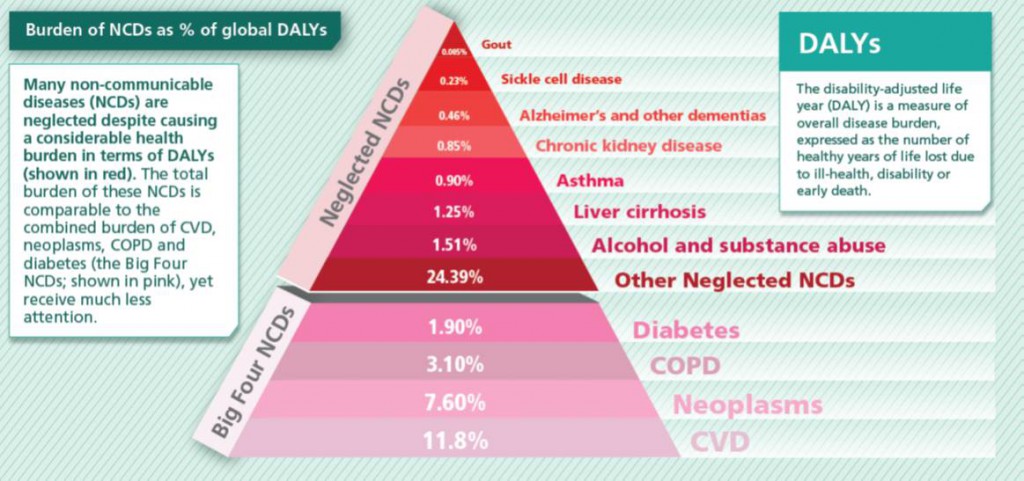Up-to-date knowledge of cause-specific mortality is essential for the formulation of health policies. Obtaining this evidence is a massive undertaking, and probably the largest attempt to do so is the landmark Global Burden of Disease Study 2010 (GBD 2010). This was the largest ever systematic effort to describe the global distribution and causes of major diseases, injuries, and health risk factors.
In the first in a series of papers published in the Lancet today, GBD 2010 has been updated to GBD 2013 three years later. The authors aimed to ascertain changes in the global, regional and national burden of mortality for 240 causes of death across 188 countries between 1990-2013. Using similarmethods to those used in GBD 2010, but with the addition of new data and improvements in their statistical modelling, the authors found several exciting results.
Medical advances, more effective disease and injury prevention strategies and improvements in living standards have seen global life expectancy for both sexes increase from 65.3 years in 1990 to 71.5 years in 2013. Much of this improvement in life expectancy is attributable to gains made in reducing age-standardised mortality from cardiovascular diseases and cancers in high-income countries, and in reducing child deaths caused by diarrhoea, lower respiratory infections and neonatal causes in low-income countries.
Nonetheless, the increase in global life expectancy has been accompanied by a rise in mortality from some non-communicable diseases, an issue that has previously been discussed in another blog. Generally, although there has been a reduction in age- and sex-specific mortality, there has been a shift towards a greater proportion of deaths being due to non-communicable disease and injury.
Rising death rates from some important NCDs such as diabetes, Alzheimer’s disease, selected vascular conditions such as atrial fibrillation, and chronic kidney disease, as well as stagnant mortality from leading causes of death such as cancers of the lung, liver, prostate, pancreas, and kidney have the potential to reverse some of these gains made in premature mortality reduction.
Among the non-communicable diseases that have contributed significantly to global premature mortality are substance use disorders, chronic kidney disease (CKD) and sickle-cell anaemia. These were highlighted earlier this year in our forum article and associated infographic that discussed neglected non-communicable diseases.

Experts that contributed to this forum article had proposed various ways in which to increase awareness of these diseases, which, while causing much premature mortality, remain under the radar.
Tom Williams, who works on sickle-cell disease, highlights that it is the lack of good quality data that limits awareness of its burden. He suggests measures such as early-life screening for sickle-cell disease and development of rapid diagnostic tests that will enable researchers to better and more quickly diagnose this disease, which could lead to better estimates of its burden.
Nora Volkow and George Koob, who specialise in substance abuse disorders, argue that addiction should be treated as a brain disease rather than a criminal or moral issue, and as such the healthcare system could and should play a larger role in prevention and treatment. Adeera Levin and Marcello Tonelli recommend better integration of research across the biomedical and clinical sciences with health systems and population-based studies, which could improve patient outcomes for CKD.
However, awareness of CKD as a major non-communicable disease has come rather late: CKD was only mentioned as ‘posing a major health burden’ in the 2011 Political Declaration of the High‐Level meeting of the General Assembly on the prevention and control of NCDs.
This was a significant achievement, since it was the first time that CKD was acknowledged as a potentially important contributor to the global burden of NCDs. However, the national NCD strategies of most countries still do not specifically address CKD, which is an issue that requires resolution (Marcello Tonelli, personal communications).
The new data provided by GBD 2013 should raise the profile of some of these neglected non-communicable diseases. In doing so, this should help establish health policies and systems to better counteract their effects on premature mortality.
 BMC Medicine: passionate about quality, transparency and clinical impact
BMC Medicine: passionate about quality, transparency and clinical impact
2014 median turnover times: initial decision three days; decision after peer review 39 days
Comments